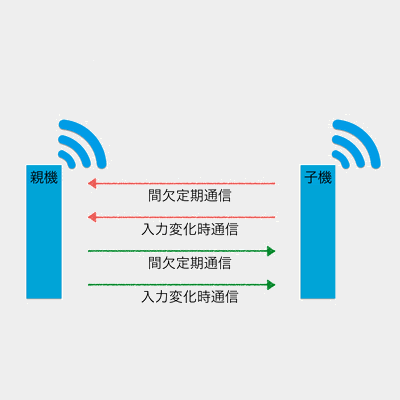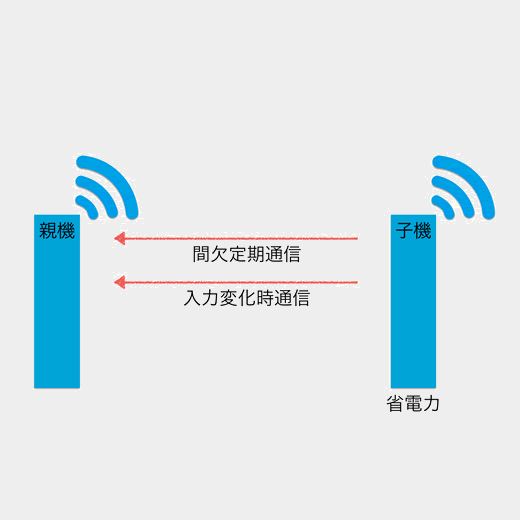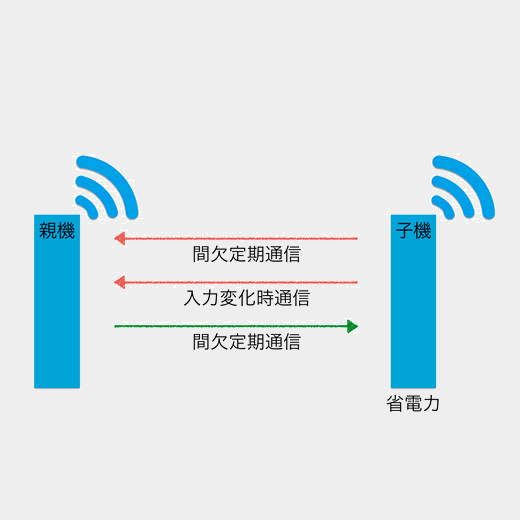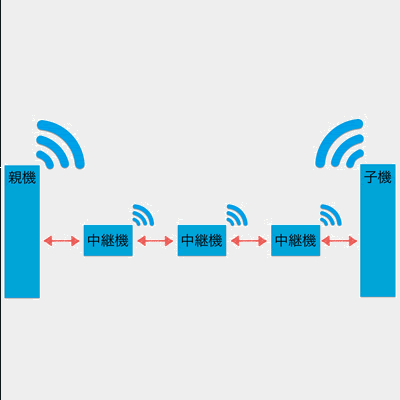Operating Modes of Extremely Simple! Standard App
List of Operating Modes
Each mode is set by leaving the Mx pin unconnected or connecting it to GND.
M3 | M2 | M1 | Mode | Function | Power | Initial |
|---|---|---|---|---|---|---|
| O | O | O | Child: | Sends input status to parent, | 120 | |
| O | O | G | Parent: | Sends input status to child, | 0 | |
| O | G | O | Repeater: | Always waits for received data | 122 | |
| O | G | G | Child: | Frequently sends input status to parent, | 123 | |
| G | O | O | Child: | Sends input status to parent every 1 second, | ✅ | 124 |
| G | O | G | Child: | Sends input status to parent every 1 second, | ✅ | 125 |
| G | G | O | - | Unused | - | - |
| G | G | G | Child: | Sends input status to parent every 10 seconds, | ✅ | 127 |
O: Not connected (OPEN), G: Connected to
GND
Initial state is Child: Continuous mode.
The initial Logical Device ID (LID) used to identify the device varies depending on the mode.
Only in Parent or Repeater modes, the LID can be switched via Interactive Mode.
Please use 121 for Parent and 122 for Repeater.
Handling of unused AIx ports
In Child: Continuous / Child: Continuous 0.03s / Parent: Continuous modes, please connect unused AIx ports to VCC.
Unused AIx ports report undefined values. These modes send data when there is a change in input signals, which may cause unnecessary data transmission.
Parent Device
Continuous Mode
Parent: Continuous Mode
When input signals change or every 1 second, data is sent to all child devices.
It always waits for data sent from child devices, providing good responsiveness but continuously consuming power.
- Reception: Always waiting
- Transmission: On input change / every 1 second
Disabling periodic transmission
0x00000002 in Interactive Mode.Child Device
Continuous Mode
Child: Continuous Mode
When input signals change or every 1 second, data is sent to all parent devices.
It always waits for data sent from parent devices, providing good responsiveness but continuously consuming power.

Communication image with parent device
- Reception: Always waiting
- Transmission: On input change / every 1 second
Disabling periodic transmission
0x00000002 in Interactive Mode.Child: Continuous 0.03s Mode
This mode shortens the periodic transmission interval of Child: Continuous Mode from 1 second to 0.03 seconds.
Although it always waits for data sent from the parent, the communication from child to parent occupies the bandwidth, making the parent’s input response slower. It continuously consumes power.

Communication image with parent device
- Reception: Always waiting
- Transmission: On input change / every 0.03 seconds
Intermittent Mode
Child: Intermittent 1s Mode
When input signals change or every 1 second, power-saving mode is canceled and data is sent to all parent devices.
Reception is disabled, so control from the parent device is not possible. This mode has excellent power-saving performance.

Communication image with parent device
- Reception: Disabled
- Transmission: On input change / every 1 second
Child: Intermittent 10s Mode
When input signals change or every 10 seconds, power-saving mode is canceled and data is sent to all parent devices.
Reception is disabled, so control from the parent device is not possible. This mode has excellent power-saving performance.

Communication image with parent device
- Reception: Disabled
- Transmission: On input change / every 10 seconds
Child: Intermittent Reception 1s Mode
When input signals change or every 1 second, power-saving mode is canceled and data is sent to all parent devices.
Reception is also performed every 1 second. It has excellent power-saving performance but is inferior to Child: Intermittent 1s Mode.

Communication image with parent device
- Reception: Every 1 second
- Transmission: On input change / every 1 second
Repeater
Continuous Mode
Repeater: Continuous Mode
The repeater forwards received packets.
Up to three repeaters can be installed between parent and child devices, but increasing repeaters increases the number of packets, which may cause interference.

Image of relaying
- Reception: Always waiting
- Transmission: On reception
0x00008000 in the option bits of Interactive Mode.